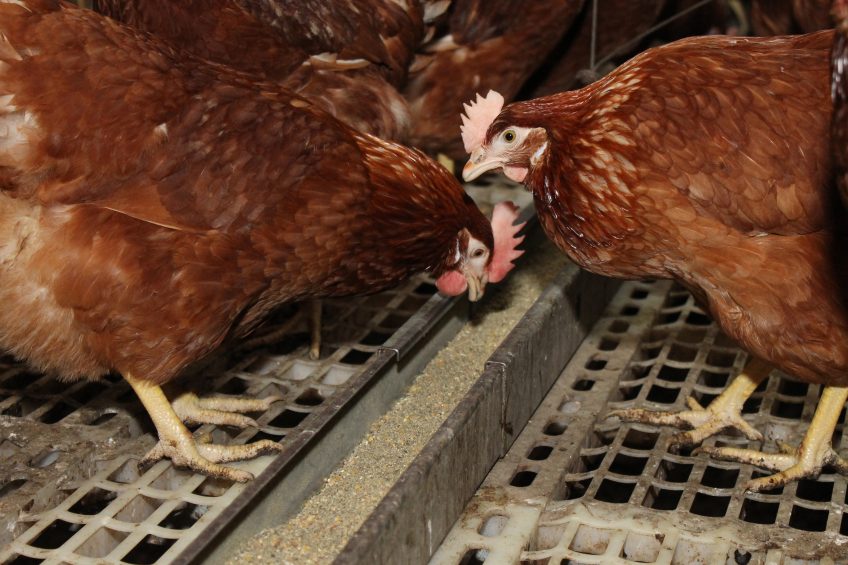Mixing feed for more tailored layer rations

More egg producers are switching from bought-in feed to tailored, home-mixed rations which can offer a greater level of flexibility, improved layer productivity and cost management.
In the past home mixing has been associated with being a dirty, imprecise task using heavy, noisy on-farm mixing equipment.
However, now, few producers invest in the milling equipment itself, instead they opt to work hand-in-hand with a feed and nutrition company which can offer a mobile service.
One such company is Harbro which provides support to 90% of poultry producers in Scotland.
Sales manager Doug Steele says: “Many egg producers associate home mixing with being a time-consuming, dusty job, but improvements in engineering and technology have made it a quick and efficient task.
“The advantage of milling and mixing on-farm versus buying in compounds is that you have complete control over what you are feeding your birds and you can adapt it from week to week to respond to changes in Key Performance Indicators such as body weight or egg weight. This can make a big difference to overall flock performance.”
11 key elements to home mixing

Initial outlay
Initial investment has also often been perceived as a barrier to switching to home mixing.
The capital outlay for building a DIY static mill and managing the process on farm is in the region of £400,000 (€455,774.73)for a mixer, electrics and silos.
But the mobile home mixing, managed by a supplier, can be from as little as finding clean, pest-free shed space or installing a silo.
“The advantage of using a mobile mixing service is that you don’t have to make the initial investment nor do you have the responsibility of skilled labour or dealing with breakdowns,” says Mr Steele.
Home grown
Whether DIY-mixing or using a mobile mill and mix service, the biggest saving is using home-grown cereals to keep ingredient costs to a minimum, while adding greater traceability for buyers. However, most home mix producers still buy in the majority of their grain and drive savings and efficiencies by improving egg numbers and feed efficiency, Mr Steele says.
A basic feed composition in home mix, includes wheat, soya, limestone, oil and minerals with additional barley, sunflower, whole rape. Peas or beans can also be added if it is advantageous for the flock’s performance.
Ration savings compared to an off-the-shelf feed are about £20-30/tonne(€22.79-34.18/tonne), Mr Steele estimates.
Added to this, he says that home mixing gives producers the flexibility to change rations to tweak performance. In contrast to buying in bulk loads of compound feed, on-farm mixing allows egg producers to regularly adapt the feed composition when required.
“When we are working with poultry farms we mill and mix on site and undertake weekly analysis of the feed and the unit’s KPIs to see where we can alter the ration to address any underlying production issues, such as shell strength, egg or body weight,” he explains.
“This could be altering the amount of protein or energy supplied in the ration, or changing the grist size.
“A diet should always be tailored to the birds, not the birds having to adapt to a diet. Success lies in incremental changes, so the birds don’t even notice, and this can only be achieved when you are constantly monitoring and adapting. One of the best performing layer flocks in the UK implemented 22 changes in its diet in 12 months.”

Meals on wheels
Harbro uses a custom-built, Austrian-manufactured vehicle called a Tropper for its mobile-mixing service. Designed with four pipes for separate intakes, the machine allows for accuracy of weighing and mixing, to within 1% of the total mix.
These mobile units mix and blow out up to 20 tonnes/hour, or up to 200 tonnes/day.
Mr Steele suggests that mixing in smaller batches allows for easy storage, and has the advantage of being fresh every week, as well as giving managers the flexibility to feed slightly different rations to individual houses if necessary.
“Another gain from independent milling is that with the right grinding, roller and hammer milling, the grist can be sized to match the freedom of flow through the farm storage units, which can markedly improve gut health, with a resulting reduction in antibiotic use, as well as feed conversion efficiency.
“People often think of home mixing as being a dirty job, but times have changed, and the payback of home mixing is not just financial, it’s a 360-degree view. It may all ultimately lead to financial gain, through the accuracy and flexibility home-mixing provides, but it also takes into account good nutrition and flock health,” says Mr Steele.
Feed complianceProducers opting for home mixing or using an on-farm mill and mix specialist need to comply with the following codes of practice and registration to current legislation:
|
Case study: Switching to home mixing mid-flock paid dividends in bird performanceYorkshire egg producer Paul Johnson switched to a home mixed ration for his 16,000 layers 8 years ago and has seen a huge improvement in condition, longevity and production in the flock. As well as a traditional flat-deck house Mr Johnson’s 300-acre farm near Terrington, North Yorkshire, grows cereals and pasture for a beef enterprise. All of the wheat grown is used as feed for the layers and barley for a beef enterprise.  Paul Johnson weighing eggs. Photo: Adrian Legge FrustrationThe switch to a home mixed ration was made in 2010 as frustration grew with a bought-in feed from a recognised supplier. He made a drastic decision when he got to a point where the birds were losing condition and egg sizes had become difficult to control. “I thought, enough is enough and did what you should never really do – I switched mid-lay from the bought-in ration to our own diet.” An existing storage area was used and divided up with some purchased concrete panels. “We shopped around for advice and chose nutritionist Harbro which offered an on-site milling and mixing service. We have never looked back.” PerformanceWithin 10 weeks the egg sizes were under tight control and the birds condition – feather cover, weight and health – had been transformed. “The only thing we have changed is the switch to tailoring our own ration. “We use the same Hyline breed as always and yet we have gone from a 72-week cycle to an 86-week cycle. “Egg production is sustained and production increased by 10-15% at certain times of the cycle,” Mr Johnson says. “We could keep them even longer such is the condition. But even so we are getting an extra three months out of each flock.” Over a 4-year period the business is saving the cost of an entire 16,000 bird flock and the associated costs of turnaround, empty houses, cleaning and transport. Mr Johnson puts the difference down to the ability to tailor the ration to exactly what the birds need and keeping a close eye on bird performance. Up to 32 weeks a 1% sample of the flock is checked over and weighed every Monday – the time-period is extended to a fortnight once the birds are older. Any changes in egg weight, bodyweight, production and feed intake are recorded and discussed with the nutritionist the same afternoon. Weekly tweaksAdjustments to the ration are fed through to the mixer unit which arrives 2 days later on the Wednesday. The ration proportions are fed into the operator’s software and the Tropper mixer unit fine tunes the consistency and does the rest. Home-grown wheat, limestone granules, soya, sunflower meal, vitamins and minerals are blown into the relevant storage bin and augered into the housing. Buying in bulk produces savings of about £40-45/tonne (€45.58-51.27/tonne) depending on the product so over the past 10 years Mr Johnson has invested in two large storage bins to allow him to purchase higher quantities. One – a 33-tonne capacity galvanised and reinforced steel silo was bought brand new at £8,500 (€9,685.21) to hold the abrasive limestone granules. The other was purchased second hand for £5,500 (€6,266.90) to hold the sunflower meal. A further set up cost of about £2,500 (€2,848.59) was spent on a new auger for the mixed feed. Limestone is bought in 30t loads, soya, 20-25t at a time and other ingredients such as oil in 5t batches. About 450t of home-grown wheat is fed annually. SavingsOverall, he estimates that the ration costs £12-18/t (€13.67-20.51/t) less than a bought-in ration depending on its relative quality. Additional benefits have been seen in bird health. The ration is consistent and dry which has allowed litter beetle to work more effectively. The scratching area is also drier, producing behavioural benefits as well as improved health. The only extra costs are involved in meeting storage regulations stipulated by the Lion Assurance Scheme. “We had to register as a mill/mixer and complete extra steps to meet requirements on feed safety and hygiene.” Mr Johnson has now taken a further step in tailoring feed, even more closely by introducing am and pm split-ration feeding. “Because we have such close control over the feed coming in, we can feed a 40:60 split where we increase protein and energy levels in the morning and calcium for shell quality in the afternoon.” “Split feeding allows us to better control egg weight which helps improve health, welfare and production still further,” he says. |













